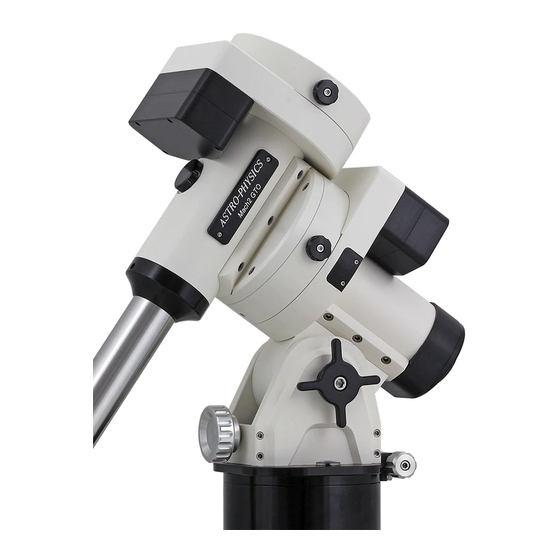ASTRO-PHYSICS 900 German Equatorial Руководство - Страница 3
Просмотреть онлайн или скачать pdf Руководство для Аксессуары ASTRO-PHYSICS 900 German Equatorial. ASTRO-PHYSICS 900 German Equatorial 12 страниц. Polar alignment telescope and illuminator (pasill)
Также для ASTRO-PHYSICS 900 German Equatorial: Краткое руководство по эксплуатации (2 страниц), Руководство (3 страниц)

BEFORE YOU LEAVE HOME
Since most of us must set up our instruments in the dark, in the cold or while battling mosquitoes, a bit of preplanning
and organization is important. There are a few simple things that can be accomplished in the comfort of your home
before heading outside.
GROSS LATITUDE ADJUSTMENT: The latitude range of the 900 mount is approximately 20-68 degrees. Since most
astronomers typically observe within one latitude range, this adjustment is made just once, if at all. Prior to
shipment, we preset the mount to your latitude range for your convenience. If you travel to another observing
location, determine the latitude of your observing site and make the appropriate adjustment.
The four positions for the altitude adjustments have the following ranges:
52 degrees to 68 degrees latitude – top position
41 degrees to 59 degrees latitude – third position
30 degrees to 45 degrees latitude – second position
20 degrees to 34 degrees latitude – bottom position
How to change the position of the altitude adjuster bar
1. Use only the R.A. axis. DO NOT attempt to make these adjustments with the declination axis in place and certainly
not with an instrument fully mounted.
2. Loosen both altitude-locking knobs about one
turn.
3. Locate the side of the polar axis that does
not have the motor/gear housing box.
Loosen (about one turn) the polar axis pivot
screw and altitude adjuster bar fixing screw
on this side only. With your hand, push the
polar axis upwards so that the altitude
locking knobs are positioned at the top of the
altitude slot (this is the maximum altitude
position). Some resistance will be felt with
this operation as you are pushing against the
weight of the polar housing and the
resistance of the remaining polar axis pivot
screw (which has not been loosened).
4. Before attempting to move the altitude
adjuster bar, you must tighten the altitude-
locking knob on the motor/gear housing side.
This will prevent any downward movement of
the polar axis during positioning of the
altitude adjuster bar.
5. While supporting the altitude adjuster bar,
remove the two screws that support it on
either side, but keep the two ends of the bar
in contact with the side of the mount, don't
remove it completely (this tip is for your
convenience).
6. Guide (wiggle) the bar to the desired
position, insert the screws in both ends and
lightly tighten so that you still have some
ability to move the bar.
7. Note that the altitude adjustment knob is
attached to a threaded rod that travels
through the altitude adjuster bar. Turn the
- 3 -
